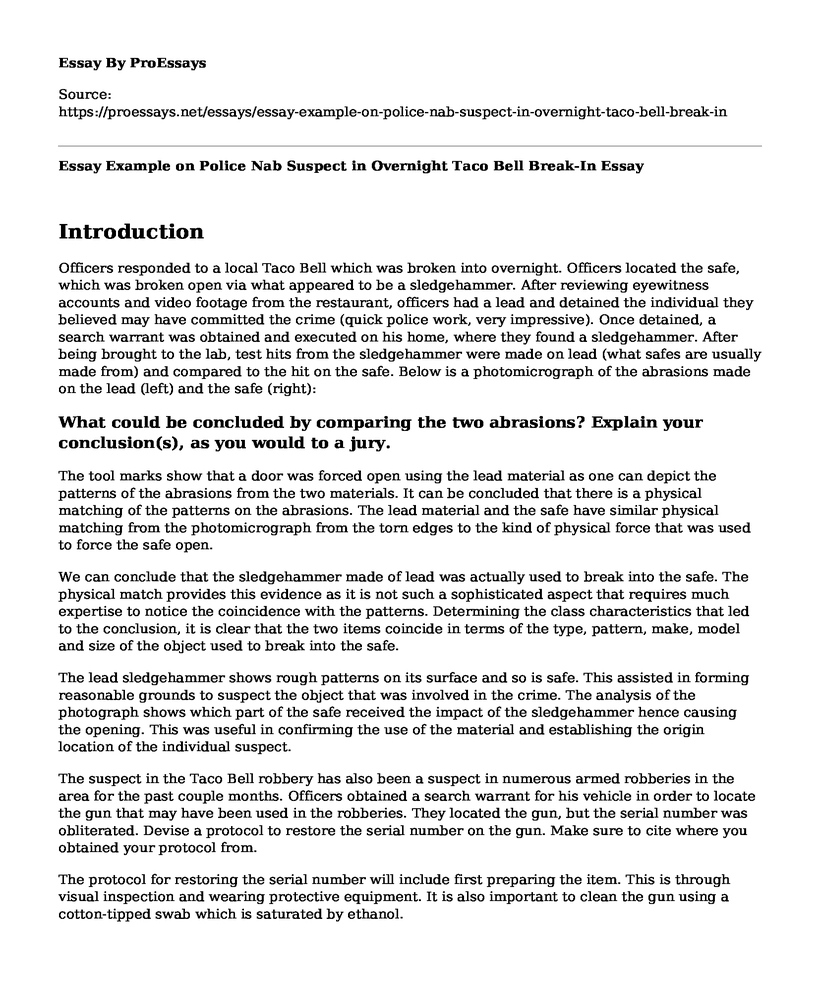Introduction
Officers responded to a local Taco Bell which was broken into overnight. Officers located the safe, which was broken open via what appeared to be a sledgehammer. After reviewing eyewitness accounts and video footage from the restaurant, officers had a lead and detained the individual they believed may have committed the crime (quick police work, very impressive). Once detained, a search warrant was obtained and executed on his home, where they found a sledgehammer. After being brought to the lab, test hits from the sledgehammer were made on lead (what safes are usually made from) and compared to the hit on the safe. Below is a photomicrograph of the abrasions made on the lead (left) and the safe (right):
What could be concluded by comparing the two abrasions? Explain your conclusion(s), as you would to a jury.
The tool marks show that a door was forced open using the lead material as one can depict the patterns of the abrasions from the two materials. It can be concluded that there is a physical matching of the patterns on the abrasions. The lead material and the safe have similar physical matching from the photomicrograph from the torn edges to the kind of physical force that was used to force the safe open.
We can conclude that the sledgehammer made of lead was actually used to break into the safe. The physical match provides this evidence as it is not such a sophisticated aspect that requires much expertise to notice the coincidence with the patterns. Determining the class characteristics that led to the conclusion, it is clear that the two items coincide in terms of the type, pattern, make, model and size of the object used to break into the safe.
The lead sledgehammer shows rough patterns on its surface and so is safe. This assisted in forming reasonable grounds to suspect the object that was involved in the crime. The analysis of the photograph shows which part of the safe received the impact of the sledgehammer hence causing the opening. This was useful in confirming the use of the material and establishing the origin location of the individual suspect.
The suspect in the Taco Bell robbery has also been a suspect in numerous armed robberies in the area for the past couple months. Officers obtained a search warrant for his vehicle in order to locate the gun that may have been used in the robberies. They located the gun, but the serial number was obliterated. Devise a protocol to restore the serial number on the gun. Make sure to cite where you obtained your protocol from.
The protocol for restoring the serial number will include first preparing the item. This is through visual inspection and wearing protective equipment. It is also important to clean the gun using a cotton-tipped swab which is saturated by ethanol.
On visual examination, one needs to make a note on the areas where the serial number is supposed to be and the physical property of the gun whether magnetic or non-magnetic. There will be the determination of the size, style, and location of the hidden numbers and characters on the serial number (North Carolina State Crime Laboratory, 2014). Note the method that was used for obliteration which could either be drilling, grounding, punching, chemical etching or scratching.
There is the preparation of the surface through polishing to remove the obliteration scratches until the surface is mirror-like. Through the magnetic particle method of inspection, the inspector will use a pipette to apply the magnetic solution to the area with the serial number.
There is then the chemical processing method where for the gun, there will be the use of Davis reagent, Fry's reagent or Turner's reagent (North Carolina State Crime Laboratory 2014). The reactivity check will ensure the use of an etchant which will be rubbed across one area. The inspector could use more than one etchant to improve clarity. If there is the appearance of the characters, distilled water will be used in the area so as to slow or stop the process of oxidation and allow for examination. The process is to continue until the number is restored.
Sadly, one of those armed robberies turned deadly. The bullet that was recovered from the scene had a "right direction of a twist" after viewing impressions left on the bullet. Exemplar 1 is a picture down the barrel of the suspect's gun. What would be your conclusion from that information alone? Where would you proceed in the investigation?
The suspect's gun is quite deadly and the picture shows that it has been used on several occasions. There are also unique marks and features that are developed from the item as a result of wear and tear and such is evident when gun has been used previously. We can examine the gun in terms of the nicks, gouges, and patterns of wear that are evident from its surface. These demonstrate a positive match from the results hence driving the conclusion. We can proceed in the investigation to determine the user by taking prints.
Reference
North Carolina State Crime Laboratory (2014). Technical procedure for Serial Number Restoration. Retrieved from https://www.ncdoj.gov/getdoc/c985eebb-36bd-46e0-94e2-b091b1496df2/Serial-Number-Restoration-11-15-2013.aspx
Cite this page
Essay Example on Police Nab Suspect in Overnight Taco Bell Break-In. (2023, Jan 29). Retrieved from https://proessays.net/essays/essay-example-on-police-nab-suspect-in-overnight-taco-bell-break-in
If you are the original author of this essay and no longer wish to have it published on the ProEssays website, please click below to request its removal:
- Montgomery College Should Allow Gun On Campus - Controversial Essay
- Role of Homeland Security Department in Managing Hurricane Sandy and Katrina
- Born a Crime - Literary Analysis Essay
- Essay Sample on Secure Courtrooms: Deterring Potential Threats
- Essay on Texas Judicial System: Keeping the Legislative & Executive Branches in Check
- Essay Example on Criminal Law: Punishing Offenders & Resolving Disputes
- Essay Example on Essential Human Right: Access to Clean Water & Sanitation







